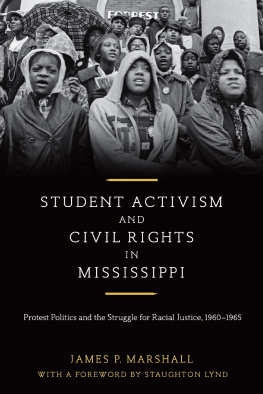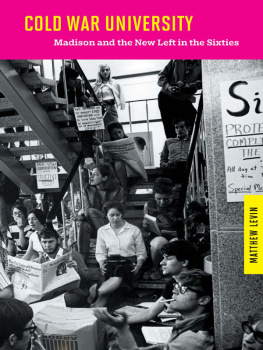Student Protest
First published 1998 by Addison Wesley Longman Limited
Published 2014 by Routledge
2 Park Square, Milton Park, Abingdon, Oxon OX14 4RN
711 Third Avenue, New York, NY 10017, USA
Routledge is an imprint of the Taylor & Francis Group, an informa business
Copyright 1998, Taylor & Francis.
All rights reserved. No part of this book may be reprinted or reproduced or utilised in any form or by any electronic, mechanical, or other means, now known or hereafter invented, including photocopying and recording, or in any information storage or retrieval system, without permission in writing from the publishers.
Notices
Knowledge and best practice in this field are constantly changing. As new research and experience broaden our understanding, changes in research methods, professional practices, or medical treatment may become necessary.
Practitioners and researchers must always rely on their own experience and knowledge in evaluating and using any information, methods, compounds, or experiments described herein. In using such information or methods they should be mindful of their own safety and the safety of others, including parties for whom they have a professional responsibility.
To the fullest extent of the law, neither the Publisher nor the authors, contributors, or editors, assume any liability for any injury and/or damage to persons or property as a matter of products liability, negligence or otherwise, or from any use or operation of any methods, products, instructions, or ideas contained in die material herein.
ISBN 13: 978-0-582-35618-4 (pbk)
British Library Cataloguing in Publication Data
A catalogue entry for this title is available from the British Library
Library of Congress Cataloging-in-Publication Data
Student protest : the sixties and after / edited by Gerard J. DeGroot.
p. cm.
Includes bibliographical references and index.
ISBN 0582356199 (CSD). ISBN 0582356180 (PPR)
1. Student movementsHistory20th century. 2. College students
Political activityHistory20th century. I. De Groot, Gerard
J., 1955 .
LB3610.S84 1998
378.1981dc21
987586
CIP
Set by 35 in 10/12pt Baskerville
In Memory of
Norman Klockman
(19541979),
who knew the joys of being a student
and
In Celebration of
Joshua Charles DeGroot,
born 28 October 1997,
for whom those joys await
Contents
Gerard J. DeGroot
J. Angus Johnston
Nella Van Dyke
Bertram Gordon
Sylvia Ellis
Eric Zolov
Gerard J. DeGroot
Ingo Cornils
Clare White
Donald Mabry
A.D. Moses
Julie A. Reuben
Sandra Hollin Flowers
Barbara L. Tischler
Gnter Minnerup
Alan R. Kluver
Behrooz Ghamari-Tabrizi
Frank N. Pieke
James L. Wood
Few subjects provoke as much obfuscating nostalgia as the 1960s student movement. Those who lived through the period like to believe that they changed the world. Those born too late play Bob Dylan records and pretend that the world did change. The subject does not, therefore, lend itself to critical analysis. Too often romantic myths and hagiography have been peddled as serious scholarship. This book attempts to break through the mists of nostalgia. It does so partly by placing the 1960s movements within the wider context of post-World War II student protest, thus countering the decades claim to uniqueness. But it does so mainly because the contributors have all equipped themselves with a hard-edged realism, the better to resist the subjects stupefying romance.
I must credit Professor John Green of the Ray C. Bliss Institute of Applied Politics at the University of Akron for the original idea which inspired this book. He thought that the time had come to produce a book which examined important examples of student protest in various countries from different disciplinary perspectives. I trust that this book is close to his original conception. I must also thank Andrew MacLennan at Addison Wesley Longman for stepping in and agreeing to publish the book on the basis of a short synopsis. Andrew is one of a kind: I challenge any writer to find an editor more gracious, kind and supportive.
The miracle of electronic mail has made producing a collection of this sort infinitely easier. It was enormously reassuring to know that I could get a message to my contributors so quickly, and receive a reply usually on the same day. But the system would have broken down long ago if not for the help of Julian Crowe, a computer wizard at my university who displayed enormous patience with my ineptitude.
I would also like to thank my colleagues Corinna Peniston-Bird, Steve Spackman, Bruce Gordon and Hamish Scott for their timely advice along the way. But, most of all, I have to thank the seventeen other contributors to this book. To a one, they submitted gracefully to my editing, and never once complained about the punishing deadlines which I set. Getting to know them, if only by electronic correspondence, has been the most enjoyable part of producing this book. I am deeply grateful for the chance to work with them.
Gerard DeGroot
University of St Andrews
February 1998
The publishers would like to thank University of California Press for permission to reproduce material from Eric Zolov, Containing the Rock Gesture: The Rise of the Mexican Counterculture, 1999 The Regents of the University of California and Gerard J. DeGroot, Left!, Left!, Left!: The Vietnam Day Committee, 196566, originally published as The limits of moral protest and participatory democracy: The Vietnam Day Committee in Pacific Historical Review 64: 1 (February 1995), pp. 95119, 1995 American Historical Association, Pacific Coast Branch.
GERARD J. DEGROOT
On 25 August 1992, Rosebud Abigail Denovo broke into the campus home of Chang-Lin Tien, Chancellor of the University of California. Denovo, aged 19, a some-time student and member of the Peoples Will Direct Action Committee, was the self-appointed judge, jury and executioner of Tien enemy of the people. An Oakland police officer, called to the scene, intervened before she could carry out her mission. She lunged at him, and he shot her dead.
On Denovos body was a note which read: We are willing to die for this land. Are you? By land, she meant specifically Peoples Park in Berkeley, first seized by students from the University in 1969, and the scene of sporadic protest ever since. Denovos revolutionary career began in the summer of 1991, in response to the decision by the University to build volleyball courts on the park. At the time of her death she was awaiting trial for possession of explosives, which were found with a hit list of campus officials responsible for the decision to build the volleyball courts. On news of her death, 150 supporters rioted in the park. It is fair to say that Denovo, born in 1973, died in the 1960s.1
On my first trip to Berkeley during the summer of 1991,1 shared a seat on the train with a woman burdened with leaflets rallying comrades to the defence of Peoples Park. One had to be impressed by her dedication. Not more than 20 years old, she shared the ideals, if not the psychotic self-destructiveness, of Denovo. Memories of the 1969 struggle would have come to both young women as secondhand myth, perhaps handed down by activist parents. Though my acquaintance has probably since graduated and perhaps even joined the establishment, a new generation of students now defend the park. Each year, recruits are drawn from the pimply-faced first-year students who listen to Maggies Farm on CD. In the words of Bob Dylan, they keep on keepin on, clinging to the tawdry symbols of an era which exists only in their imagination. They still march and sit-in, but have added to their armoury some decidedly modern weapons: a website and writs filed in California law courts. When history repeats itself, it does so in stereo and living colour.







